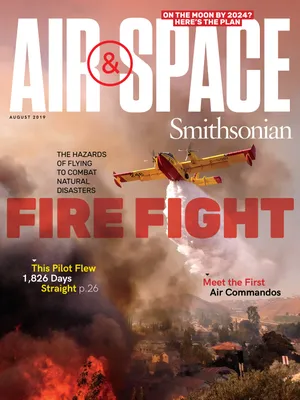The History of Aviation and Spaceflight is the Story of Explorers
From the Director of the Smithsonian’s National Air and Space Museum
/https://tf-cmsv2-smithsonianmag-media.s3.amazonaws.com/filer/9b/75/9b75a8ac-3e0b-43c7-8c04-29066ea86a36/25a_aug2019_titan_pia17655_fig1_live.jpg)
My first encounter with planetary science happened long before I started work at NASA’s Jet Propulsion Laboratory (JPL). My father was a rocket engineer, and when I was 14, he took me along to the launch of the Viking spacecraft to Mars. NASA held talks where families could meet the scientists, and one of them, Carl Sagan, explained to me that there might be signs of life on Mars if we could only turn over the right rocks. The idea of turning over rocks on another planet to find answers was incredibly exciting, and that conversation sparked in me the single trait that is essential to the success of any scientist: curiosity.
NASA has sent many spacecraft to visit Mars since that time—even naming one of the rovers for surface exploration “Curiosity”—and each mission has built on the knowledge gained by its predecessors. It seems that the more answers we find, the more curious we become. In the 1970s with the twin Voyager spacecraft (see p. 84), we expanded our search for answers to the outer solar system. The Voyager missions helped us develop the next set of questions for probes returning to Jupiter and Saturn and now, astonishingly, for spacecraft studying planetary systems orbiting other stars.
The history of exploration—of momentous discoveries building on past insights—is the story we tell at the National Air and Space Museum. One of our iconic artifacts, the first airplane, is the result of the Wrights’ thorough survey of centuries of aeronautic research. And their legacy includes the careful steps they took after the moment of discovery, methodically building an industry around their invention. At the Museum, we seek to help pass the baton, sparking curiosity in the next generation with stories about the previous one.
Later in my career, my team and I proposed a mission to Saturn’s moon Titan, building on the discovery of giant lakes there. For four years, we refined our plan to send a ship to sail on Titan’s sea. After beating 24 competitors to make the final round, we lost out to a mission to Mars. My team didn’t get to sail the first craft on Titan, but we had, as Wilbur Wright wrote to the Smithsonian more than a century before, “availed ourselves of all that was already known and added our mite to help on the future workers who will attain final success.” If history is any indicator, others will dream of Titan and surely find their way.
